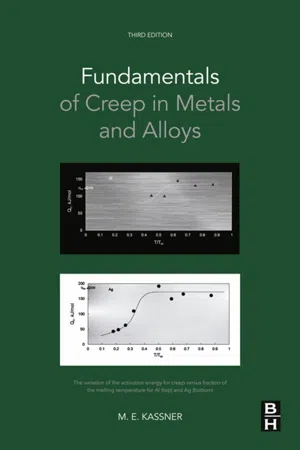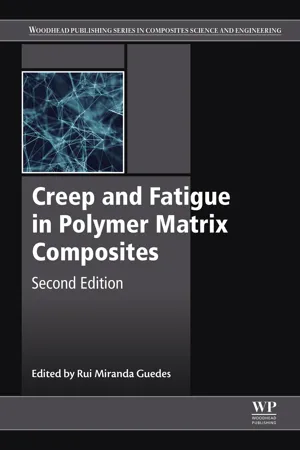Creep in Materials
Creep in materials refers to the slow, time-dependent deformation that occurs under constant load or stress at elevated temperatures. It is a phenomenon commonly observed in materials such as metals, plastics, and ceramics. Creep can lead to permanent changes in the shape and dimensions of a material, making it an important consideration in the design and performance of engineering components operating under high temperatures and loads.
7 Key excerpts on "Creep in Materials"
- eBook - ePub
Practical Guide to the Packaging of Electronics
Thermal and Mechanical Design and Analysis, Third Edition
- Ali Jamnia(Author)
- 2016(Publication Date)
- CRC Press(Publisher)
...Appendix F: Creep When a material is subjected to external loads, the internal structure (i.e., grain lattice, crystals, or molecules, in the case of many plastics) has to move in order to be aligned in a formation that would withstand the external loads. This new alignment may be called a state of stress, considering that there would be a tendency for the material to revert back to its natural state once the loads are removed. If enough energy (generally in the form of heat) is provided, this internal structure tends to accept the new formation as a natural state, and thus the state of stress is either lessened or relieved altogether. This phenomenon is called creep and is defined by Lau (1993) as a mathematical model to represent the behavior of rate-sensitive elastoplastic materials at elevated temperatures. Clearly, this behavior depends on the material’s properties and temperature levels, along with residence time at those levels and applied loads. In and of itself, creep may not be considered a failure mechanism; however, it may lead to catastrophic failures. If creep is allowed to continue, deformations are enlarged and, eventually, strains become so large that the structure loses its load-carrying capacity and fails either in a buckling mode or a stress rupture. Nearly all materials exhibit creep near their melting points. Although this proximity to the melting point varies from material to material, in general, once temperature value surpasses 50% of the melting point, creep and strain rates associated with creep become important factors that may not be ignored. In electronics packaging, solders and plastics are particularly at risk because of their relatively low melting temperatures and operating temperatures that may exceed the 50% threshold (Pecht 1991; Lau 1993; Lau et al. 1998). Stages of Creep The process of creep development is not uniform or constant. Figure F.1 depicts a typical creep curve with the three stages of creep identified...
- eBook - ePub
Additive and Traditionally Manufactured Components
A Comparative Analysis of Mechanical Properties
- Joshua Pelleg(Author)
- 2020(Publication Date)
- Elsevier(Publisher)
...The rate of deformation is a function of exposure time, temperature, and applied load and depends on material properties. Creep is the tendency of a solid material to move slowly under the influence of mechanical stress but still below the yield strength and deform permanently. Creep is more severe in materials that are subjected to heat for long periods and generally increase as their temperature increase until a critical failure (dimensional and shape changes, which makes a component useless) is reached near the melting point. Therefore, creep is of concern to engineers when designing components to operate under high stress or high temperatures. However, creep may occur at relatively moderate temperatures in many cases. Even some ceramics with low-temperature ductility may creep ~ 0.5 T m. An important consideration is the choice of the type of material, namely, single or polycrystalline material. In order to eliminate grain boundary sliding in the material while exposed to some elevated temperature single crystal is the obvious choice. However, for many reasons such as other mechanical properties or cost factor consideration, polycrystalline materials are used despite their limitations for high-temperature applications. Grain size is a factor. A compromise must be made between small grain size, which enhances most of the mechanical properties, and large grained material, which is preferred for long-time exposure (creep) at high temperature. Ti6Al4V alloy also known as Ti64 is the most commonly used titanium alloy. It exhibits good mechanical and physical properties and due to its lightweight it is used in aerospace applications. These unique properties are strongly affected by chemical composition, microstructure, deformation, and heat-treatment history. The most commonly used titanium alloy is the two-phase (α + β) alloy. Significant research was devoted to improving the microstructure and attaining appropriate mechanical properties...
- eBook - ePub
- Michael E. Kassner(Author)
- 2015(Publication Date)
- Butterworth-Heinemann(Publisher)
...Chapter 1 Fundamentals of Creep in Materials Abstract Creep of materials is classically associated with time-dependent plasticity under a fixed stress at an elevated temperature, often greater than roughly 0.5 T m, where T m is the absolute melting temperature. The plasticity under these conditions is described for constant stress and constant strain-rate conditions. Several aspects of the curve require explanation. First, three regions are delineated: Stage I, or primary creep, which denotes that portion where the creep rate (plastic strain rate), ɛ ˙ = d ɛ /d t is changing with increasing plastic strain or time. The primary creep rate decreases with increasing strain, but with some types of creep, such as solute drag with “3-power creep,” an “inverted” primary occurs where the strain rate increases with strain. Analogously, under constant strain rate conditions, the metal hardens, resulting in increasing flow stresses. Often, in pure metals, the strain rate decreases or the stress increases to a value that is constant over a range of strain. The phenomenon is termed Stage II, secondary, or steady-state creep. Eventually, cavitation and/or cracking increases the apparent strain rate or decreases the flow stress. This regime is termed Stage III, or tertiary, creep and leads to fracture. Sometimes, Stage I leads directly to Stage III and an “inflection” is observed. Thus, care must sometimes be exercised in concluding a mechanical steady state. Keywords Creep; Plasticity; Strain rate; Stress Contents 1. Introduction 1 1.1 Description of Creep 1 1.2 Objectives 6 1. Introduction 1.1. Description of Creep Creep of materials is classically associated with time-dependent plasticity under a fixed stress at an elevated temperature, often greater than roughly 0.5 T m, where T m is the absolute melting temperature. The plasticity under these conditions is described in Figure 1 for constant stress (a) and constant strain rate (b) conditions...
- eBook - ePub
Phenomenological Creep Models of Composites and Nanomaterials
Deterministic and Probabilistic Approach
- Leo Razdolsky(Author)
- 2019(Publication Date)
- CRC Press(Publisher)
...In order to analyze the engineering creep deformations of composite materials, one should classify them from the macro-structural point of view, living aside the manufacturing process and dealing with the final composite material product. It has to be mentioned again that the final product of any engineering creep analyses is limited in most cases to obtaining the stress-strain relationship as function of temperature (time) and its application to structural analysis and design. The matrix material can enhance the stiffness and therefore creep performance of the structure and it can be regulated by the mathematical expression of modulus of elasticity Ε(θ) in Equation (2.1) [ 4 ]. It is assumed here that the memory function K (t, t’) in this case is affected by high temperature and it might be (or might be not) affected by the rheological composition of the material, for instance, nonNewtonian nonlinear viscosity. A strong dependence on temperature (time) of the properties of soft composites (PMS) exists compared with those of other materials such as metals and ceramics (MMC and CMC). This strong dependence is due to the viscoelastic nature of PMC. Generally, PMC behave in a more elastic fashion in response to a rapidly applied temperature rise (force) and in a more viscous fashion in response to a slowly applied temperature increase. Viscoelasticity means behavior similar to both purely elastic solids in which the deformation is proportional to the applied force and to viscous liquids in which the rate of deformation is proportional to the applied force. The behavior of composites is very complex due to this dual nature...
- eBook - ePub
- Fujio Abe, Torsten-Ulf Kern, R Viswanathan(Authors)
- 2008(Publication Date)
- Woodhead Publishing(Publisher)
...8 Fundamental aspects of creep deformation and deformation mechanism map K. Maruyama Tohoku University, Japan 8.1 Introduction This chapter deals with the phenomenology of creep deformation. Mechanical properties such as yield stress and ultimate tensile strength are determined by tensile tests under constant strain rate. Deformation modes are different below (elastic) and above (plastic) the yield stress. On the other hand, creep tests under constant stress (or load) provide the creep properties necessary for structural materials for high temperature use. Creep deformation rate varies during a test from a high speed just after loading to a low speed around the minimum creep rate. It should be understood what is going on in the course of creep deformation. This chapter provides suggestions on how to understand creep behavior of engineering materials based on the stress– strain response of materials. Special attention is also paid to stress-accelerated creep tests for evaluating long term creep behavior. The athermal yield stress is a key point for appropriate evaluation of creep properties under service conditions. The athermal yield stress is the critical stress above which instantaneous plastic deformation takes place during loading. The difference in creep deformation behavior above and below the athermal yield stress will be examined. Creep tests are carried out over wide ranges of stress and temperature, and creep deformation rate varies widely from 10 ‒8 to 10 h ‒1. Several creep deformation modes appear depending on the creep test conditions. The deformation mechanism map is another subject of this chapter. It can provide useful information, for example which creep mode is operative under a given creep condition. 8.2 Stress–strain response of materials Suppose a specimen is subjected to a tensile test at a strain rate, ε ˙, at room temperature...
- William N. Findley, Francis A. Davis(Authors)
- 2013(Publication Date)
- Dover Publications(Publisher)
...However, stress relaxation behavior can be treated using the same concepts. 11.2 Nonlinear Creep Behavior at Elevated Temperatures In Chapter 7 and Appendix A2, the nonlinear constitutive equation derived was for isothermal conditions. Consequently the kernel functions of the nonlinear constitutive equation, as shown in (7.9) and (7.10), are independent of temperature. In principle this isothermal constitutive equation is applicable for describing creep behavior under all isothermal states, but the kernel functions at each temperature are different. Therefore, the total strain ε under a given temperature, T, and given stress can be represented by (11.1) where ε t is the strain due to stress and time and ε T is the tensor of thermal expansion. In (11.1) the tensorial form of the strain is utilized. The tensor for thermal expansion ε T can be represented by the following due to the fact that thermal expansion only changes normal strains for homogeneous isotropic materials, (11.2) where α(T) is the thermal expansion. α(T) in (11.2) may be a nonlinear function of temperature and stress, though for most materials α(T) is approximately a linear function of temperature over the usual range of temperature in structural applications. The creep strain ε t in (11.1) is represented by (7.9) provided the kernel functions as given in (7.10) are dependent on temperature as well as on time variables as follows: (11.3) where (11.4) In Chapter 8 and Chapter 9, methods were discussed for determining the kernel functions under isothermal conditions. In order to obtain an explicit form for the temperature dependence as well as time dependence of the kernel functions, creep experiments such as those suggested in Chapters 8 and 9 at several constant temperature levels instead of one temperature, are required. The number of the temperature levels required depends on the temperature range of interest in the application, the property of the material and the accuracy required...
- eBook - ePub
- Rui Miranda Guedes(Author)
- 2019(Publication Date)
- Woodhead Publishing(Publisher)
...However, this approach was proved to be successful in a limited strain-rate/time scale, due to the assumption that a constant number of flow units were available for transition during creep. In the work by Ranghavan and Meshii (1994), a spectrum of activation processes was used to model a creep procedure in a wider time range. In Raghavan and Meshii (1997), the creep of unidirectional carbon fiber reinforced polymer composites, as well as the epoxy matrix, both characterized as thermorheologically complex, was successfully modeled in a wide range of temperature and strain. The creep procedure of these composites in a temperature range of 295–433 K and at various stress levels up to 80% of the material's tensile strength could be described. Good qualitative agreement regarding the shape of viscoelastic functions, as well as satisfactory predictive model capability, has been verified. It was found that this creep mechanism is not altered by the presence of fibers; however, creep rate and magnitude are substantially affected by increasing the resistance to cooperative chain segmental mobility of the polymer chain segments and stiffening the matrix. In the following section, and referring to the small strain regime, it is shown that thermal activation theory can be a successful tool for the description of viscoplastic response during creep for polymeric composites, when it is combined with a proper mechanism for calculating the rate of plastic deformation, accumulating with time. Finite deformation analysis, on the other hand, has a need for many engineering applications of polymers and polymeric composites. A lot of research has dealt with finite elastic–plastic or viscoplastic deformation of polymers, but little attention has been paid to polymeric composites, in spite of the fact that they can attain high strain values, especially at high temperatures...






